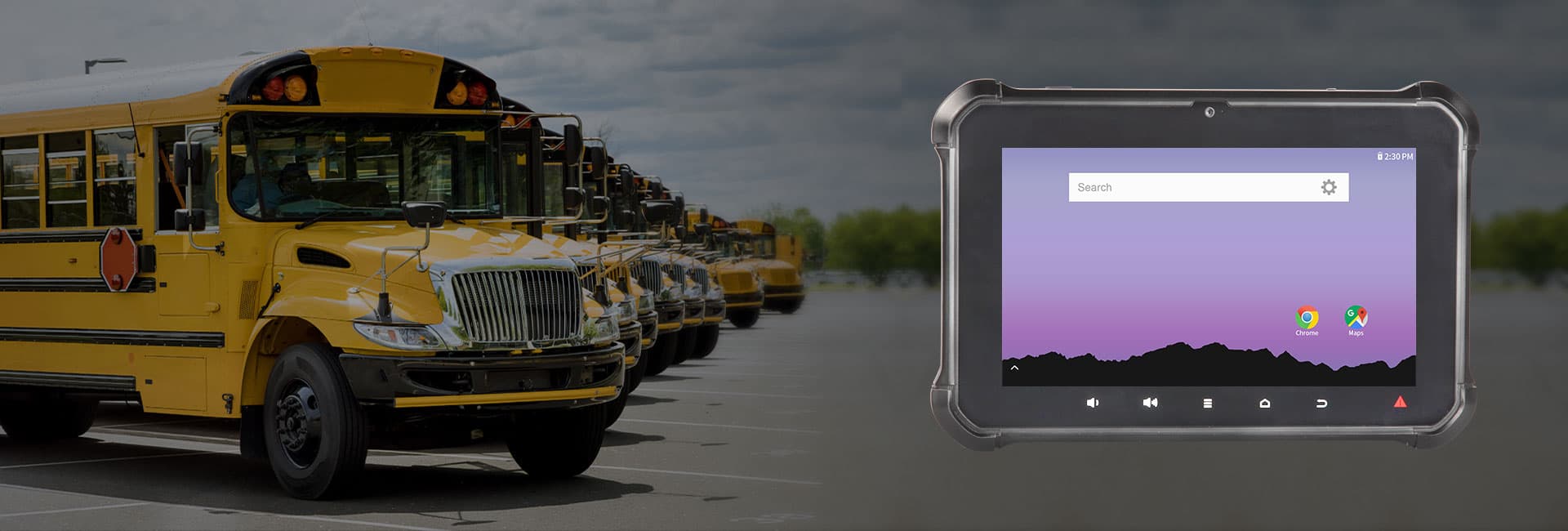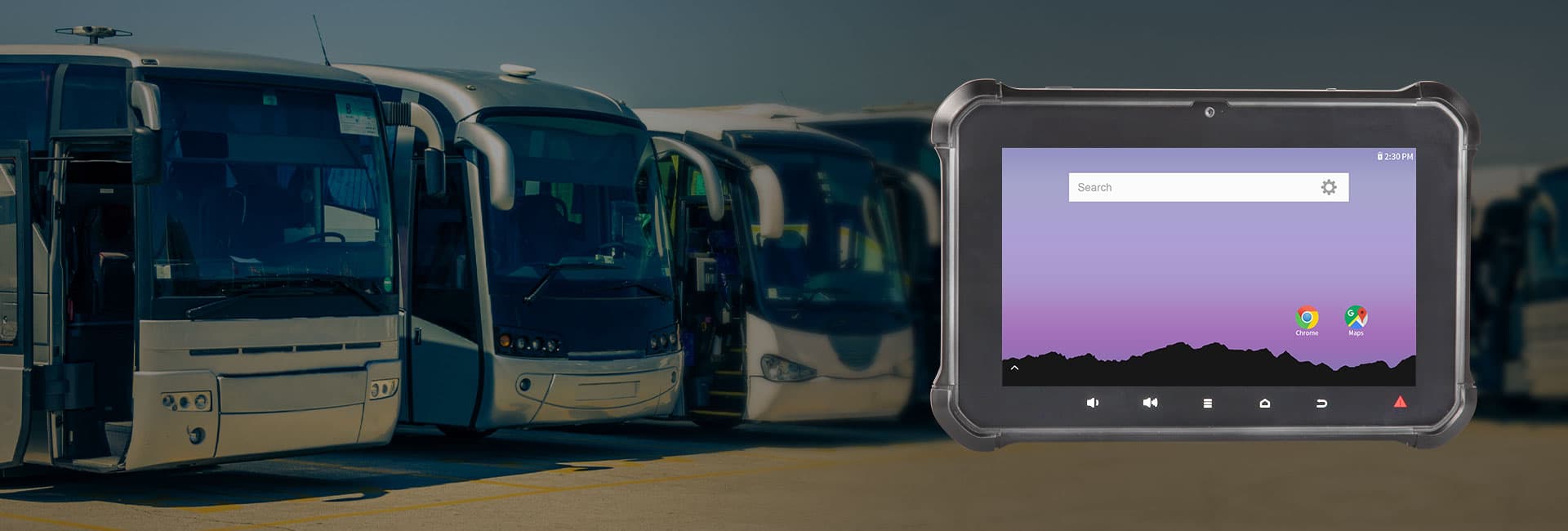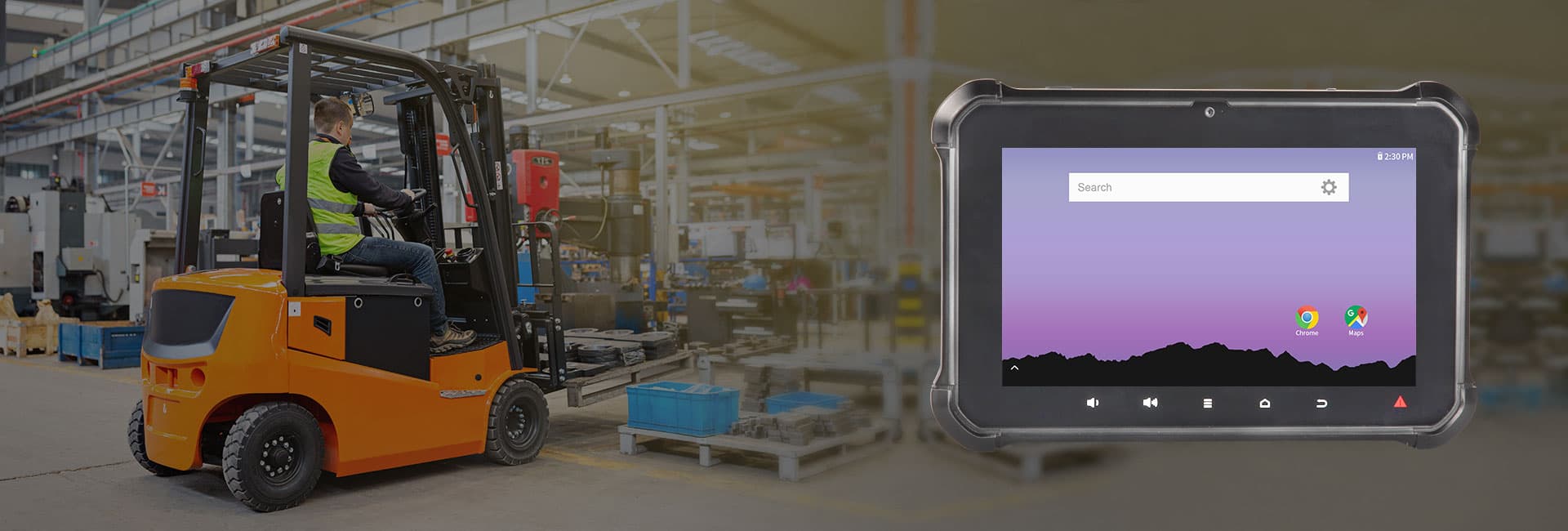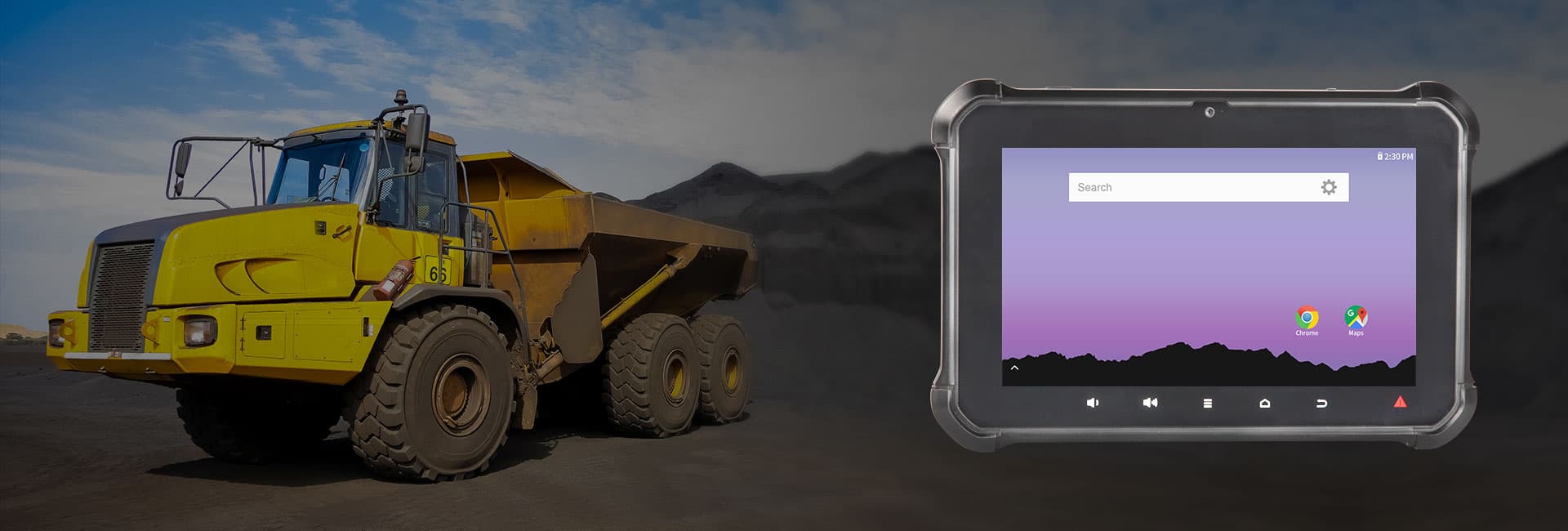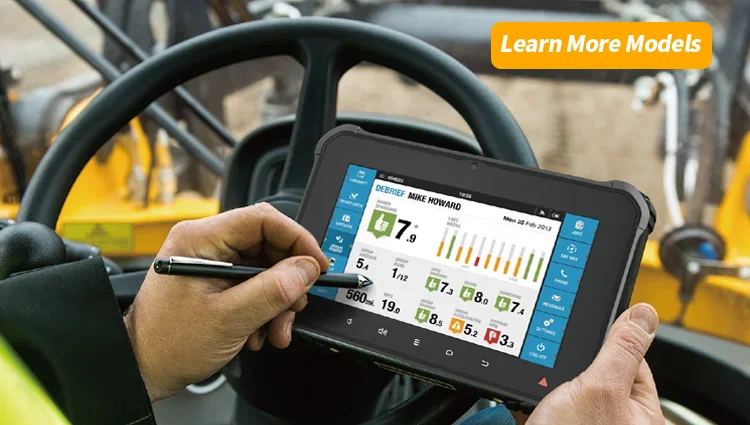Home > Blog > Driving Success: Why Rugged Tablets Are a Game-Changer for the Taxi Industry
Driving Success: Why Rugged Tablets Are a Game-Changer for the Taxi Industry
Time: 2025-07-15 Editor: Hitekon Rugged Vehicle Tablet Rugged Vehicle Tablet Manufacturer
Think about a taxi – it’s a mobile office, a customer service hub, and a navigation center all rolled into one. It faces constant bumps, spills, and the general wear and tear of being on the road for hours on end, day in and day out. For years, traditional dispatch systems or clunky, purpose-built hardware ruled the roost. But times, they are a-changin’! Enter the unsung hero of modern taxi fleets: the rugged tablet.
These aren’t your typical consumer-grade devices that buckle under pressure; oh no, these are purpose-built powerhouses designed to withstand the brutal realities of life inside a cab. From enduring endless vibrations and sudden stops to surviving spilled coffees and the occasional rough handling, a reliable rugged tablet isn’t just a fancy gadget; it’s an absolute necessity. It’s the nerve center for everything from navigating tricky city streets and accepting cashless payments to managing dispatch requests and ensuring driver compliance. In an industry where efficiency, reliability, and customer satisfaction are paramount, these hardy devices are truly the workhorses keeping the wheels turning smoothly, come what may!
Why Go Rugged? The Unbeatable Edge in the Taxi World
The life of a taxi is anything but gentle. Think about it: constant vibrations from the engine and road, the potential for accidental drops or knocks, extreme temperature fluctuations from blazing summers to freezing winters, and let’s not forget the occasional spilled drink from a passenger. A standard consumer tablet, while perfectly fine for Browse at home, would simply crumble under such relentless assault. That’s precisely why rugged tablets for taxi operations aren’t just an option; they’re a strategic imperative. They’re built like proverbial tanks, ready to shrug off impacts, spills, and environmental extremes that would send an ordinary device straight to the tech graveyard.
Built for the Bumps: Hallmarks of True Durability
When we say “rugged,” we’re talking about more than just a thick case. It’s about a fundamental design philosophy and a battery of certifications that guarantee these devices can truly take a licking and keep on ticking, shift after shift.
- MIL-STD-810H Certified: This isn’t just a fancy acronym; it’s the gold standard for military-grade durability. It means the tablet has undergone rigorous testing for drops (often from several feet), shocks, vibrations (crucial in a vehicle!), extreme temperatures, humidity, and more. It’s like a tough-guy bootcamp for electronics!
- IP Ratings (Ingress Protection): These ratings, such as IP65, IP67, or IP68, tell you exactly how well the device is sealed against dust and water. An IP65 rating, for example, means it’s dust-tight and can withstand low-pressure water jets from any direction – perfect for splashes or quick clean-ups. Higher ratings like IP67 or IP68 signify protection against immersion, so a spilled drink isn’t the end of the world.
- Wide Operating Temperature Ranges: From scorching city heatwaves to bone-chilling winter mornings, rugged tablets for taxi services are designed to perform reliably across a vast spectrum of temperatures. This is absolutely critical for vehicles that operate year-round in diverse climates.
- Vibration and Shock Resistance: The constant jostling, potholes, and vibrations in a moving taxi can wreak havoc on delicate electronics. Rugged tablets are engineered with internal dampening, solid-state drives (SSDs), and robust components to absorb these stresses, ensuring long-term reliability.
- Sunlight Readability and Brightness: Glare can be a real nuisance, making screens impossible to read, especially during bright sunny days. High-brightness displays (often 800+ nits) with anti-glare coatings are a common and vital feature, ensuring excellent visibility even in direct sunlight, keeping drivers safe and on track.
- Glove-Friendly Touchscreens: Taxi drivers might wear gloves in colder weather or for hygiene reasons. Many rugged tablets feature capacitive touchscreens that are responsive even when gloved, ensuring seamless operation without fumbling.
The Real Cost of Flimsy: Why Durability is a Smart Investment
“Why splurge on a rugged device when a cheaper consumer tablet seems to do the job?” This is a common question, and the answer, unequivocally, lies in the total cost of ownership (TCO). While the initial price tag for a rugged tablet might be higher, consider the hidden and ongoing costs of opting for a flimsy alternative:
- Frequent Replacements: Consumer devices simply aren’t built for the taxi environment. They fail often, leading to continuous replacement costs, which add up quickly. It’s like pouring money down the drain!
- Lost Productivity and Downtime: A broken tablet means a driver can’t receive dispatch requests, process payments, or navigate effectively. This leads to missed fares, delays, frustrated passengers, and ultimately, lost revenue for the business. Time is money, right?
- Repair Costs and Delays: Even if a consumer device can be repaired, the cost and turnaround time can be substantial. Sending devices out for repair means they’re out of commission, impacting your operational capacity.
- Data Loss: A damaged tablet can result in irretrievable trip data, payment records, or other critical information, causing compliance issues or accounting nightmares.
- Safety Concerns: In critical navigation situations or emergencies, a malfunctioning device could compromise driver or passenger safety.
Simply put, investing in rugged tablets for taxi fleets isn’t an expense; it’s a savvy investment in uninterrupted operations, enhanced efficiency, improved driver morale, and ultimately, your bottom line. It’s a no-brainer when you look at the bigger picture and the long-term benefits.
Powering Every Ride: How Rugged Tablets Revolutionize Taxi Operations
Modern rugged tablets are far more than just tough. They are sophisticated, multi-functional tools packed with features that empower taxi drivers and fleet managers to operate with unparalleled efficiency, safety, and insight. They truly act as the digital brain of the vehicle.
Enhancing Driver Efficiency and Passenger Experience
- Integrated Dispatch and Navigation: Say goodbye to separate devices and clunky paper trails! Rugged tablets seamlessly integrate with sophisticated dispatch software, allowing drivers to receive real-time ride requests, view optimal routes, and get turn-by-turn navigation all on one screen. This streamlines the pickup process and reduces dead mileage.
- Seamless Payment Processing: Cash is becoming a thing of the past. Rugged tablets for taxi services often feature integrated credit card readers (NFC, EMV chip, magstripe) or can easily pair with external payment terminals via Bluetooth. This enables quick, secure, and touchless payment options, enhancing convenience for passengers and ensuring drivers get paid promptly.
- Real-time Communication: Instant two-way communication between drivers and dispatchers is crucial. These tablets facilitate clear, reliable messaging, often with push-to-talk (PTT) capabilities, enabling quick updates on traffic, passenger status, or emergencies.
- Digital Trip Logging and Reporting: Automate trip logging, fare calculations, and shift reports. Drivers can easily record mileage, passenger counts, and special requests, minimizing manual paperwork and reducing administrative burden at the end of a shift. This also provides accurate data for compliance and accounting.
- Passenger Wi-Fi Hotspot: Many rugged tablets with cellular connectivity can double as a Wi-Fi hotspot, a fantastic perk for passengers to stay connected during their ride, significantly enhancing the customer experience. This can be a real differentiator for your service!
- In-Cab Entertainment and Information: Some advanced setups allow for a separate screen for passengers, powered by the rugged tablet, offering entertainment, local information, or even targeted advertising, adding value to the ride.
Streamlining Fleet Management and Back-Office Operations
- GPS Tracking and Geofencing: Fleet managers gain real-time visibility into the location of every vehicle. This isn’t just about knowing where your cabs are; it’s about optimizing dispatch, monitoring compliance with geofencing (e.g., ensuring drivers stay within designated zones), and improving security.
- Telematics and Vehicle Diagnostics: Many rugged tablets can integrate with the vehicle’s onboard diagnostics (OBD-II) port. This provides valuable data on driving behavior (speeding, harsh braking), fuel consumption, engine health, and more. This telematics data is invaluable for driver training, optimizing fuel efficiency, and proactive maintenance, keeping your fleet in tip-top shape.
- Driver Identification and Security: Features like NFC or even fingerprint readers can be integrated for secure driver login, ensuring that only authorized personnel can operate the vehicle’s system.
- Remote Management and Updates: IT teams can remotely manage and update the tablets’ software, applications, and security patches. This minimizes the need for vehicles to return to the depot for maintenance, saving valuable time and money.
- Proof of Service and Dispute Resolution: Digital records of pickups, drop-offs, routes taken, and payment confirmations provide irrefutable proof of service. This can be invaluable in resolving customer disputes quickly and efficiently.
In a nutshell, rugged tablets for taxi operations aren’t just a piece of hardware; they are a comprehensive solution that elevates every aspect of the taxi business. They bridge the gap between the driver, the passenger, and the dispatch center, ensuring seamless information flow and operational excellence that keeps your business rolling in the right direction.
The Perfect Match: Picking the Right Rugged Tablet for Your Taxi Fleet
Choosing the ideal rugged tablet for your taxi fleet is a significant decision that will impact your operations for years to come. It’s definitely not a one-size-fits-all scenario, and careful consideration of several factors is key to ensuring you pick a device that’s truly up to the task and perfectly aligned with your business needs.
Key Specifications and Features to Prioritize
- Operating System (OS):
- Android: This is often the preferred choice for taxi fleets. It offers tremendous flexibility, a vast ecosystem of apps, and is generally more cost-effective. It’s highly customizable, which is great for integrating specific taxi dispatch and payment applications. Drivers are usually familiar with the Android interface from their personal devices, easing adoption.
- Windows: While less common for pure taxi operations, Windows-based rugged tablets are ideal if your existing fleet management or back-office software primarily runs on Windows and requires deep integration. They offer a more traditional desktop-like experience. Choose an OS that aligns best with your existing software infrastructure and the applications your drivers will use daily.
- Processor and RAM: These components dictate the tablet’s overall speed and its ability to run multiple applications smoothly (e.g., navigation, dispatch, and payment processing simultaneously). Opt for a modern, multi-core processor (like Intel Core i5/i7 or equivalent ARM processors) and at least 8GB of RAM for fluid performance. Don’t cheap out here; a slow tablet will frustrate drivers and cost you time.
- Storage: Solid-State Drives (SSDs) are a must for rugged environments due to their shock resistance and faster performance compared to traditional Hard Disk Drives (HDDs). Consider sufficient internal storage (e.g., 128GB or 256GB SSD) for the OS, essential apps, and map data. Expandable storage via microSD cards can be useful for additional data if needed.
- Display Size and Brightness:
- Size: Tablets typically range from 8 to 12 inches. A larger screen (10-12 inches) provides better visibility for complex maps, dispatch details, and passenger-facing interactions. However, consider the vehicle’s interior space and driver’s line of sight.
- Brightness (nits): This is paramount for outdoor readability. Look for screens with at least 800 nits, and ideally 1000+ nits, especially if your taxis operate frequently in direct sunlight. Anti-glare and anti-fingerprint coatings are also highly beneficial.
- Battery Life: While vehicle-mounted, a tablet still needs robust battery life for when it’s unmounted for inspections, handovers, or in case of power interruption. Look for devices with 8+ hours of active battery life and consider models with hot-swappable batteries or robust vehicle docks that provide continuous charging.
- Connectivity Options:
- Cellular (4G LTE / 5G): Absolutely essential for real-time dispatch, navigation updates, and payment processing in the field. Ensure broad band support for various carriers.
- Wi-Fi (Dual-Band 802.11ac/ax): For faster data transfer at the depot, downloading large map updates, or serving as a passenger hotspot.
- Bluetooth: For connecting crucial peripherals like external payment devices, portable printers, or OBD-II dongles.
- High-Precision GPS/GNSS: Support for multiple satellite systems (GPS, GLONASS, Galileo, BeiDou) ensures faster lock times and more accurate location tracking.
- Integrated Peripherals and Ports:
- Barcode Scanner: While perhaps not strictly necessary for every taxi, it could be useful for package delivery services or specific loyalty programs.
- NFC: Crucial for contactless payments (e.g., Apple Pay, Google Pay) and potentially for driver ID verification.
- Cameras: Front and rear cameras can be useful for documenting vehicle conditions, accidents, or even as security cameras (with privacy considerations).
- USB Ports (Type-A, Type-C): For connecting external devices or for charging.
- Ethernet Port (Optional, via dock): For a stable wired connection at the depot.
- GPIO/Programmable Buttons: Some rugged tablets offer programmable buttons that can be assigned to frequently used functions (e.g., “accept fare,” “emergency call”), enhancing driver efficiency.
- Mounting Solutions: How will the tablet be securely and safely mounted in the vehicle? Look for devices that are compatible with industry-standard VESA mounts or have proprietary vehicle docks. These docks often provide charging, external antenna passthrough, and secure locking mechanisms, ensuring the tablet stays put even during sudden stops or turns. Ease of docking and undocking for shift changes is also a key consideration.
The Vendor’s Vigilance: Beyond the Hardware
It’s not just about the device itself; the support and relationship with the vendor are equally crucial for a smooth deployment and long-term success.
- Warranty and Support: What kind of warranty is offered? Are extended warranties and service level agreements (SLAs) available? What’s the typical repair turnaround time? Robust support is vital to minimize downtime and keep your taxis on the road.
- Customization and Integration: Can the manufacturer or a third-party integrator pre-load your specific taxi dispatch software, configure settings, or even custom-brand the devices?
- Longevity and Lifecycle Management: How long will a particular model be available? Will spare parts be accessible for repairs for years to come? This is incredibly important for large deployments to ensure consistency and ease of maintenance.
- Fleet Management Software Compatibility: Ensure the chosen tablet integrates seamlessly with your existing or planned taxi dispatch and fleet management software. This is a deal-breaker!
By diligently weighing these factors, you can make an incredibly informed decision and select rugged tablets for taxi operations that not only withstand the daily grind but genuinely enhance your fleet’s efficiency, driver satisfaction, and ultimately, your profitability. It’s a significant investment, so “measure twice, cut once,” as the old adage goes!
Frequently Asked Questions (FAQs) About Rugged Tablets for Taxis
Q1: Can a rugged tablet replace my existing dedicated taxi meter and dispatch system?
In many cases, yes, absolutely! Modern rugged tablets for taxi services are designed to be multi-functional hubs that can consolidate several pieces of equipment into one. With the right software applications, a single rugged tablet can seamlessly integrate your dispatch system, GPS navigation, and even act as a digital taxi meter (though local regulations might still require a certified physical meter for legal fare calculation in some jurisdictions). Many solutions also incorporate secure payment processing. This consolidation not only reduces clutter in the vehicle but also simplifies operations for the driver, lowers hardware costs, and streamlines data flow, making it a powerful “all-in-one” solution for a truly modern taxi fleet.
Q2: How do rugged tablets handle data security, especially with payment processing and passenger information?
Data security is paramount for any business, especially one handling sensitive payment and passenger information. Rugged tablets for taxi operations prioritize this with several layers of protection:
- Secure Hardware: The devices themselves often include hardware-level security features, such as trusted platform modules (TPMs), secure boot, and encryption capabilities, making them resistant to tampering.
- Operating System Security: Both Android and Windows, when properly configured, offer robust security features like encryption for data at rest, user authentication (PINs, passwords, biometrics), and app sandboxing to isolate applications.
- PCI DSS Compliance: For payment processing, the integrated software and hardware solutions are typically designed to comply with Payment Card Industry Data Security Standard (PCI DSS) regulations, ensuring that cardholder data is handled securely from swipe/tap to transaction.
- Data Encryption: Data transmitted over cellular networks or Wi-Fi is often encrypted (e.g., via VPNs or HTTPS) to prevent interception.
- Remote Management: Fleet managers can remotely wipe devices in case of loss or theft, ensuring sensitive data doesn’t fall into the wrong hands. They can also push security updates and patches over-the-air to maintain a high level of protection.
In short, these devices are built with security in mind, offering a much more robust solution than relying on consumer-grade tablets for critical business functions.
Q3: What kind of connectivity options do rugged tablets offer for real-time dispatch and GPS tracking?
Connectivity is the backbone of modern taxi operations, and rugged tablets for taxi fleets excel here, offering a comprehensive suite of options:
- High-Speed Cellular (4G LTE / 5G): This is the primary and most crucial connection for real-time dispatch updates, receiving new ride requests, transmitting GPS location data to the fleet management system, and processing cashless payments. Many tablets support multiple LTE bands for broad carrier compatibility.
- Dual-Band Wi-Fi (802.11ac/ax): Essential for faster data transfers when parked at the depot (e.g., downloading large map updates, uploading extensive log data), and increasingly, for offering in-cab Wi-Fi hotspots to passengers as a value-added service.
- Bluetooth: Used for short-range wireless connections to various peripherals, such as external credit card readers, portable receipt printers, OBD-II diagnostic dongles, or even a Bluetooth headset for hands-free communication.
- High-Precision GNSS (GPS, GLONASS, Galileo, BeiDou): Far more advanced than typical smartphone GPS, these modules offer faster satellite acquisition and more accurate location tracking, even in challenging urban environments with tall buildings (“urban canyons”), ensuring precise navigation and reliable fleet tracking.
By combining these robust connectivity features, rugged tablets ensure that taxi drivers remain constantly connected to dispatch, navigation, and payment systems, no matter where their journey takes them.
Previous: Powering Your Fleet: The Definitive Guide to Rugged Tablets
Next: Best Rugged Tablet Android for 2025: Top Picks for Tough Environments
Copyright © 2025.Hitekon Rugged Vehicle Tablet All rights reserved.
Public Transportation, Taxi Dispatch, Mining, Forklift Safety, Fleet Management, Precision Agriculture

